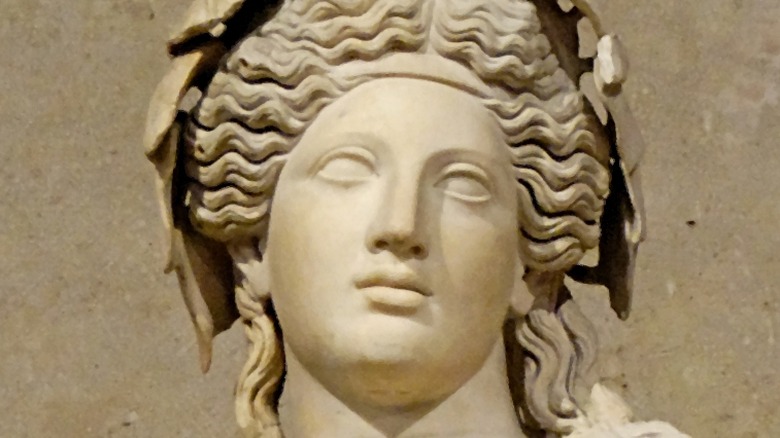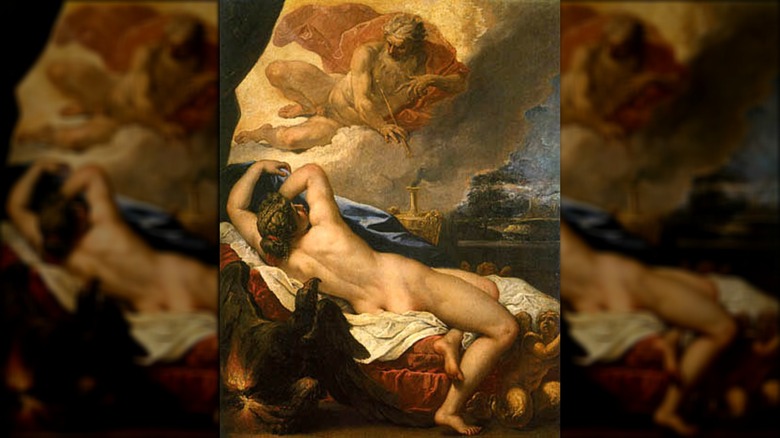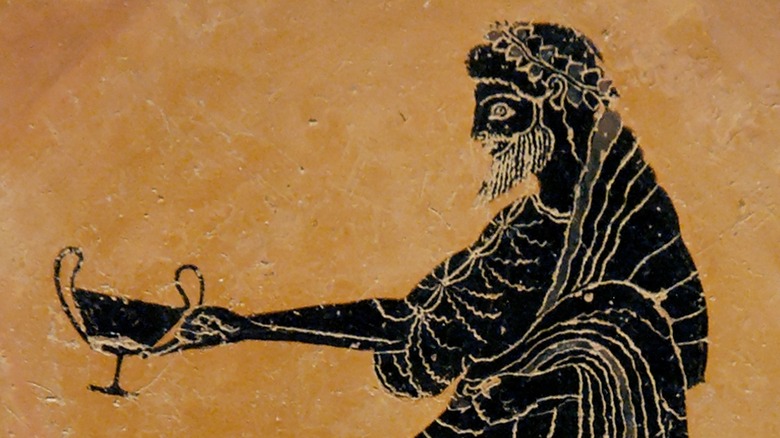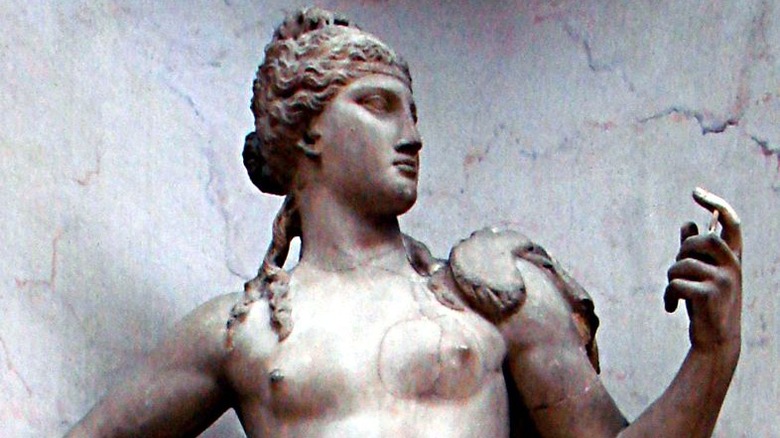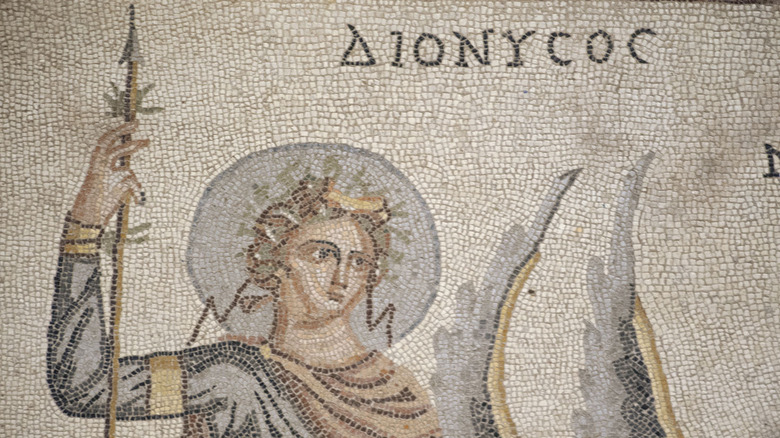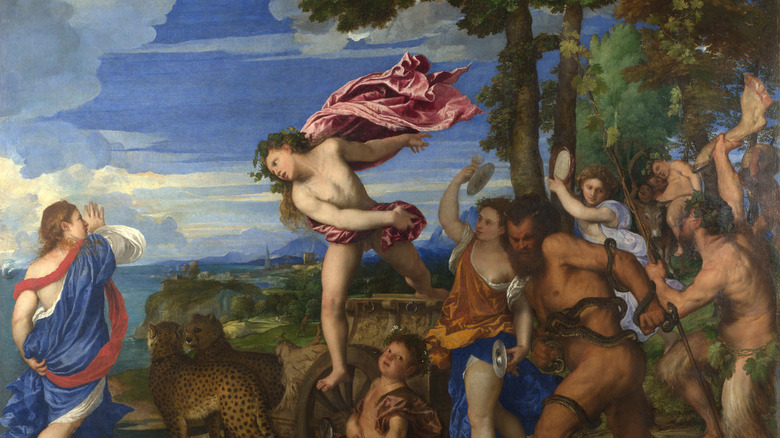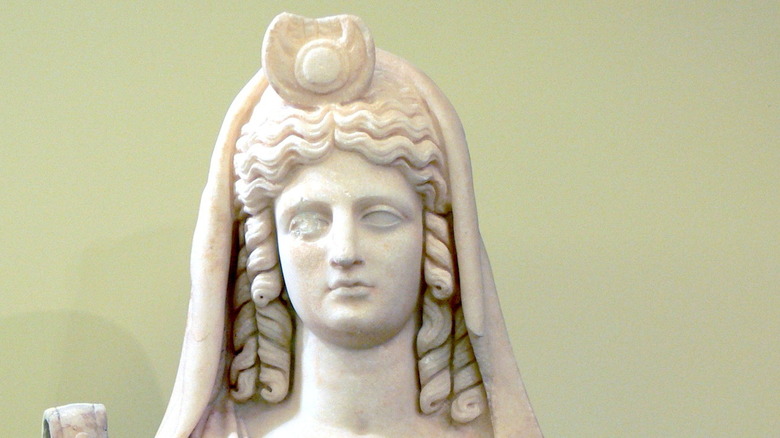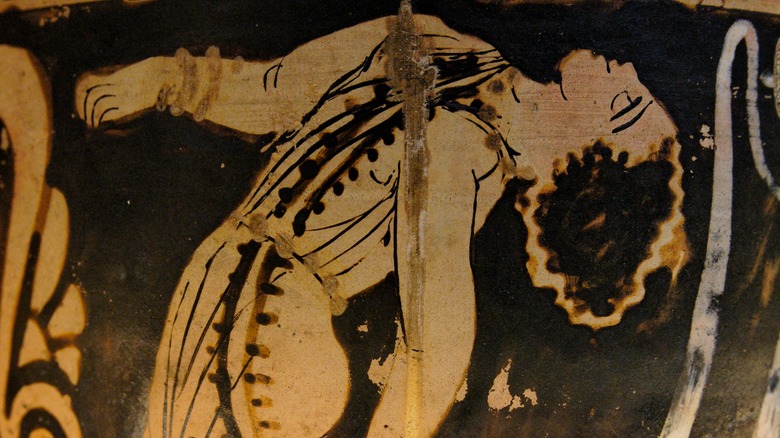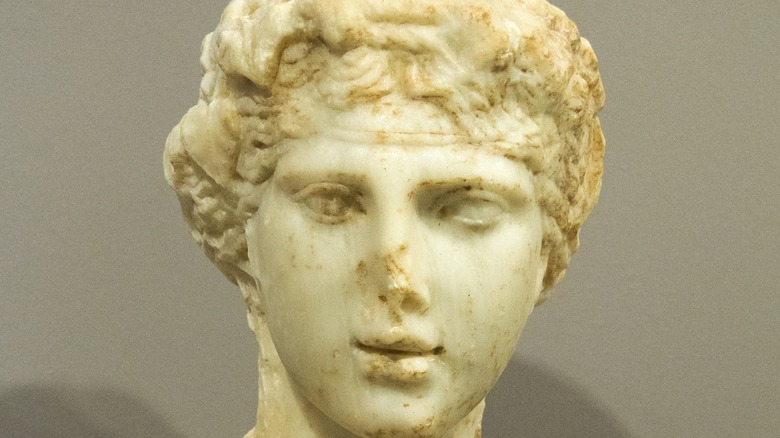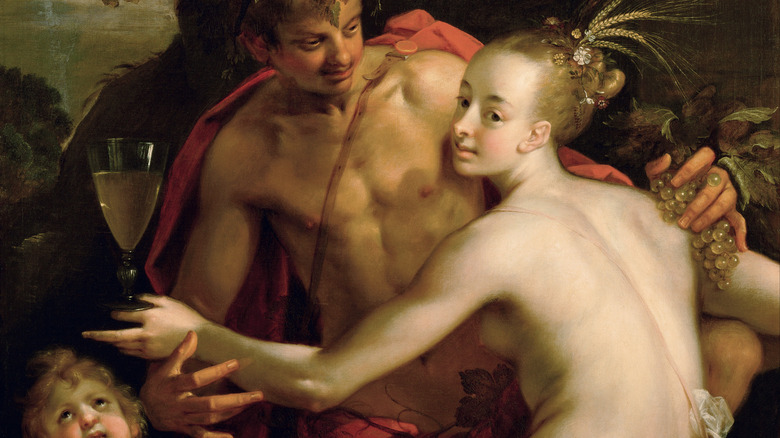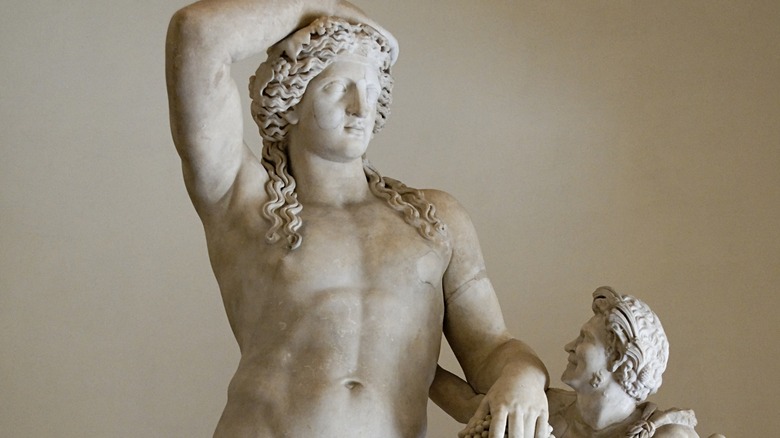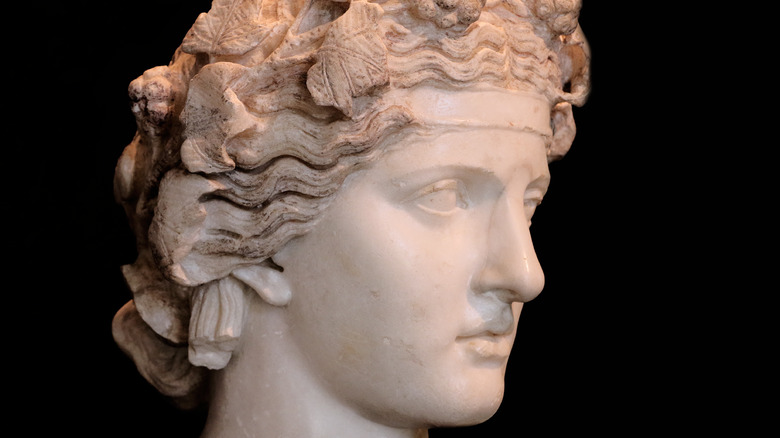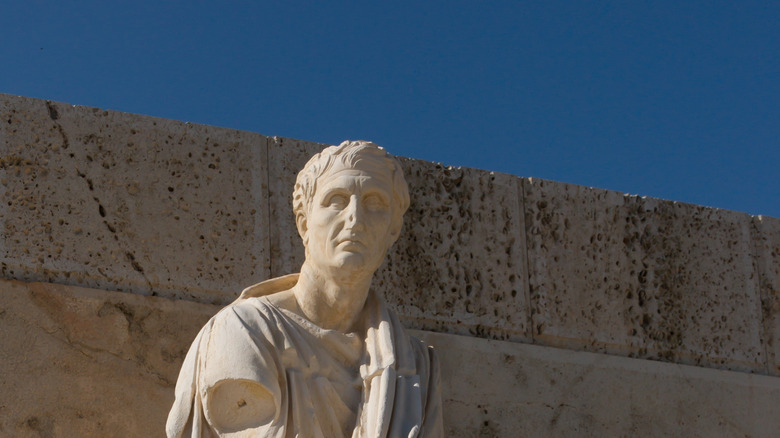The Mythology Of Dionysus Explained
Dionysus was the Greek god of wine, fertility, and madness. Wine can bring people to the brink of despair or the heights of joy, and Dionysus similarly had two natures, bringing ecstasy and madness alike to his followers and enemies.
As the son of Zeus with a mortal, Semele, Dionysus was actually the only full-fledged god who had a mortal parent, writes GreekMythology.com. Additionally, because wine was as necessary to the Greeks as life itself, he was one of the most important deities. He was also the last god on the Olympian Council.
During his early years, Dionysus traveled to spread the art of winemaking, as well as his own divinity. He was regularly escorted by a group of maenads (wild women) and satyrs (nature spirits) during his journeys. Dionysus was generally a helpful god, and many of his sacred animals also helped him in some way. Dionysus similarly rewarded many of his friends and loved ones by placing them in the sky as constellations. The god of wine earned many nicknames and experienced various adventures before ascending to the heights of Mount Olympus.
Traditional origins of Dionysus
In the more traditional Greek myth of Dionysus, the king of the gods, Zeus, had an affair with a mortal, Semele, who became pregnant. A jealous Hera, who was Zeus' wife, tricked Semele into asking Zeus to see his divine form, though this would kill her. Even knowing the outcome, Zeus granted the request. The brilliance of Zeus' divine form did kill Semele, but Zeus was able to save the half-divine Dionysus and seal him inside his thigh until he was ready to be born. Thus Dionysus was the second child after Athena to be born directly from their father Zeus, since she sprang fully formed from his head.
Dionysus is considered "twice-born" by being born from his father after being in his mother's womb, writes ThoughtCo. However, this label fits due his role in the Orphic mysteries, where he actually does have two mothers. Dionysus is sometimes called "dimetor" or "of two mothers" for the same reasons. The unusual method of his birth painted Dionysus as more of an outsider than the other gods, since he had been part of both life and death. This is also a large part of why he is a fertility and agricultural deity, since both work with the life cycle.
Youth and early travels
There are conflicting myths as to who Dionysus was raised by, writes Greek Gods and Goddesses. To hide him from Hera's wrath, Zeus put Dionysus into the care of Silenus (a satyr), and the nymphs (female nature spirits) of Mount Nysa, from which his name was possibly derived. Silenus can later be seen as one of Dionysus' main followers. Zeus rewarded the nymphs for their work by placing them in the sky where they became the Hyades, part of the constellation Taurus, the bull. This explains why another of Dionysus' sacred animals is the bull. According to another myth, Dionysus later lived with his aunt Ino and her husband Athamas. For revenge, Hera had them driven mad, which caused them to kill their own children and each other, according to Theoi.
Dionysus eventually learned the secrets of the grapevine and winemaking, and is, according to myth, the first person who made wine from grapes. At the beginning of his travels, Hera cursed him with madness. He wandered Greece until the Titan Rhea (his grandmother) found him and cured him. She also taught him various secrets regarding life and death. This new knowledge complemented his status as an agricultural deity, since he worked directly with the life-and-death cycle. Dionysus then began to travel in earnest to share his knowledge of winemaking.
Dealings with Greeks as a young god
Dionysus first traveled around Greece to share his divinity. Several of his myths involve Dionysus cursing various people with madness because they were disrespectful to him.
According to Theoi, pirates accosted Dionysus and his companions, hoping to sell them into slavery, and the irate Dionysus gave them visions of vines and wild animals and then turned them into dolphins, one of his sacred animals. King Pentheus of Thebes refused to accept Dionysus as a god, and as punishment, Dionysus caused his daughters to go mad and tear his body to pieces. Like the other Greek gods, Dionysus did not take well to being made fun of or ignored.
Another myth deals with the betrayal of a man Dionysus helped and shows off his relatively beneficial nature. Icarius of Athens wanted to learn the craft of winemaking, so Dionysus taught him. Icarius gave a group of shepherds some of the wine he had made, and thinking they were being poisoned, the shepherds murdered him. Icarius' daughter and their dog subsequently killed themselves in grief. Dionysus, deeply moved, set the three separately in the constellations Bootes, Virgo, and Canis Major.
Dionysus went even further by punishing the entire city-state of Athens, instead of just the shepherds. He caused the women of the city to go mad and instituted a drought. Athens consulted an oracle and constructed a festival for the three dead, thus lifting the punishment from the god (via Theoi).
Dionysus' exploits in Asia
After his adventures in Greece, Dionysus traveled to Asia, explaining how to make wine to those who wanted to learn and spreading his own divinity.
Along the way, Dionysus decided to invade the entire country of India, writes The Wire. Specifically, Zeus requested that he do so, since the Indians weren't worshipping the Greek gods or drinking wine. Oh, the horror! Dionysus thus gathered an army of maenads (wild women), satyrs, and demigods to march on India. Dionysus and his army eventually triumphed over India's ruler, Deriades, who was partly of the river and therefore only drank water.
The resulting war is recounted in the epic poem "Dionysiaca" by Nonnus of Panopolis, who probably wrote it between the late 300s and early 400s C.E. He was the last writer to revere the Greek gods and thus included every myth he possibly could find regarding Dionysus in his 20,000-line poem. Though the "Dionysiaca" was forgotten during the Middle Ages, it was rediscovered in the 1600s.
Marrying Ariadne and creating the Corona Borealis
Dionysus rescued one of the princesses of Crete, Ariadne, from the island of Naxos after she was abandoned by the Greek hero Theseus. Ariadne helped Theseus slay her half-brother, the Minotaur of the labyrinth. Afterwards, however, Theseus abandoned her. Some myths claim he was coerced to leave her behind (perhaps by Dionysus, who already planned to marry her), while others say a storm randomly blew Theseus' ship away from the island while Ariadne was still ashore (via Greek Legends and Myths).
Dionysus married Ariadne and put her wedding crown (forged by Hephaestus) into the stars as the Corona Borealis constellation. The constellation's brightest star, Gemma, is so named for "jewel" in Latin, writes Constellation Guide. Zeus eventually granted Ariadne immortality, and she and Dionysus had several sons, who all became lords of wine-producing Greek islands. Ariadne is often depicted, after her marriage, either on Olympus or taking part in the revels her husband and his companions were famous for.
Adventure to the Underworld and ascension
Dionysus traveled down to the Underworld to rescue his mother, Semele. Occasionally, his wife Ariadne is included in his quest as well. In one story that took place prior to his Underworld trip, Perseus of Argos met Dionysus in battle after denying him entry to his city. In the battle, Perseus killed the mortal Ariadne, and Dionysus sought to bring her back from the dead. In the end, he successfully brought back his wife and mother.
Zeus granted both Semele (now renamed Thyone) and Ariadne immortality, and Dionysus finally ascended to his place in Olympus and on the Olympian Council, writes Theoi. Most myths agree that Hestia, the goddess of the hearth and the oldest of the Olympians, gave up her seat on the council in favor of Dionysus. Dionysus also may have brought Hephaestus up to Olympus after he was cast out by his mother Hera. It's possible they ascended to their Council seats together.
Dionysus' dual nature
Dionysus had a dual nature, as wine was able to loosen people's inhibitions in many ways. Dionysus brought religious ecstasy and joy. However, wine — and Dionysus — could also bring blinding rage, not to mention madness. His followers often experienced ecstasy in his presence and during revels, while Dionysus was usually the one to curse others with madness.
Dionysus was called Eleutherios, which meant "the liberator" because his wine, not to mention the music and dancing that was part of his rites, freed his followers from social constraints (via Greek Gods and Goddesses). One of Dionysus' other epithets was "Bromios," or "roaring." One myth attributes this to the cacophony of noise his followers made during their revels, writes Theoi. Being possessed by wine also meant being possessed by Dionysus, since he was a part of his followers when they were drunk. Freeing his revelers from known social mores emphasized just how much of an outsider Dionysus was from the other gods and law-abiding Greeks. Dionysus and his followers did not fit in with the rest of society, nor did they want to.
Dionysus' appearance and bisexuality
In artwork, Dionysus generally has two depictions: one of an older, bearded man and the other of a youth who is somewhat effeminate and androgynous-looking, writes Theoi. In some myths, Dionysus was raised as a girl when he was young.
In addition to his marriage, Dionysus had several male lovers. In one myth, he made a promise to Prosymnus of Argos to have sex with him in exchange for the latter to guide him to the Underworld when attempting to retrieve his mother's spirit. By the time Dionysus finally made it back to Prosymnus, he had died. Dionysus used a wooden phallus to keep his word symbolically, according to Out.
Ampelos is the other famous male lover of Dionysus. He was a satyr who was killed while attempting to ride a wild bull. Dionysus put his image in the stars as a constellation and may have also turned him into the first grapevine (via Theoi).
Connections with nature, Apollo, and Demeter
Dionysus is seen as the protector of all trees through his protection of the grapevine; he is therefore connected to Demeter by their powers in nature. Dionysus and Demeter are considered two of the main gods of the earth, writes Greek Gods and Goddesses. In most instances, both Demeter and Dionysus were helpful towards humans; the harvest, after all, is generally bountiful. Persephone, Demeter, and Dionysus were all gods involved in the Eleusinian Mysteries and were thus worshipped at Eleusis. The Eleusinian Mysteries were secret rites centering around the life cycle and the afterlife.
Dionysus is also connected to Apollo because both gods had oracles in Greece. Dionysus and his wine were able to influence men and women into new ideas; he therefore had an oracle in Thrace (via Theoi). Dionysus was also, like Apollo, a healer and helped sufferers by passing on the right cure through their dreams.
As a god of agriculture — and one who frequented wild places — Dionysus was uniquely suited to nature and the harvest. Additionally, one of his natures was madness itself, which meant he was also used to curing people.
Cult of Dionysus
During his travels, Dionysus began to be followed by satyrs and maenads, otherwise known as women he had driven mad with ecstasy. Generally, maenads were depicted as reaching this state through frenetic dancing, music, and drink, writes Brewminate. Since he was the god of festivity, cult centers for Dionysus began to crop up across Greece, including on Naxos and Mount Kithairon, which was the birthplace of the Bacchic Orgies (via Theoi). Dionysus' Roman form was called Bacchus.
The cult of Dionysus emphasized many of his more disruptive attributes, such as drinking and dancing oneself into a frenzy. The cult at first had to do with the life-death cycle of the grapevine and the making of wine, and it also dealt with other components of wine such as honey, as well as bees. Several of Dionysus' sacred plants and animals made appearances, too; for example, ivy was thought to abate drunkenness.
The Dionysian cult also concerned itself with spirit possession by drinking and dancing to drums and pipes. People believed they would be possessed by animal spirits, but everyone wanted most to be possessed by Dionysus or his wife Ariadne, according to Hellenica World.
Dionysus' outsider nature was a large part of his cult, writes Greek Gods and Goddesses. It was seen as something that moved easily between society and the wilderness as Dionysus did.
Dionysus' role in the Orphic mysteries
In the Orphic mysteries, supposedly founded by the poet Orpheus (who also traveled down to the underworld in search of his wife), Dionysus (here called Zagreus) is the son of Zeus and his daughter Persephone. Zeus wanted his son to have control of the entire universe, so the Titans killed the child and, for good measure, ripped his body into pieces. Athena, thinking quickly, managed to hold back a piece of Zagreus: his heart, writes InfoPlease. Zeus swallowed it, and Dionysus grew anew inside him. In other retellings, Zeus took the heart and implanted it into Semele, and Dionysus grew normally.
The Titans were vaporized by Zeus' lighting. In this myth, the human race came from the ashes that remained. Humanity held a dual nature of divinity and evil, due to the natures of Dionysus and the Titans being added in. The Orphic mysteries worked heavily with this duality in humanity, and through initiation into the mysteries, humans could purge their evil Titan influence and become holy. Orphism emphasized the Dionysian, divine side of humanity, working to keep initiates pure.
Persephone's status as his almost-mother is a possible reason why she and Hades later allowed Dionysus to bring his actual mother Semele (and sometimes his wife Ariadne) up from the Underworld when so many others weren't allowed to bring their loved ones back from death.
Festivals of Dionysus
Festivals in honor of Dionysus mainly involved celebrating wine and the harvest, writes The Collector. Dionysus had four major annual festivals: the Anthesteria, the City Dionysia, the Lenaia, and the Rural Dionysia. Athenian women in particular, but prisoners and slaves as well, were allowed to experience freedom from their everyday lives during the festivals. Tragedies and comedies were put on and judged as part of the festivities, writes History Et Cetera.
The Anthesteria took place in Attica and Ionia in February. A three-day event, the festival was a symbolic rite of passage for infants, who wore flower crowns. The festival symbolized the ripening of the grapevine and included a fertility ritual and a lot of wine drinking.
The City Dionysia was held in Athens each March in honor of Dionysus Eleuthereus, another of Dionysus' names associated with his cult. It's likely that the cult and the festival were both established during the sixth century B.C.E. The festival began with ritual sacrifices and singing at the god's temple.
The Lenaia was an Athenian winter festival. It included a procession with an effigy of Dionysus, as well as music and dancing. Comic and tragic plays were judged during the Lenaia.
The Rural Dionysia was much older than the other festivals, and it eventually evolved into the City Dionysia. This series of events took place in Attica throughout the month of December and included a fertility ritual with a procession included.
